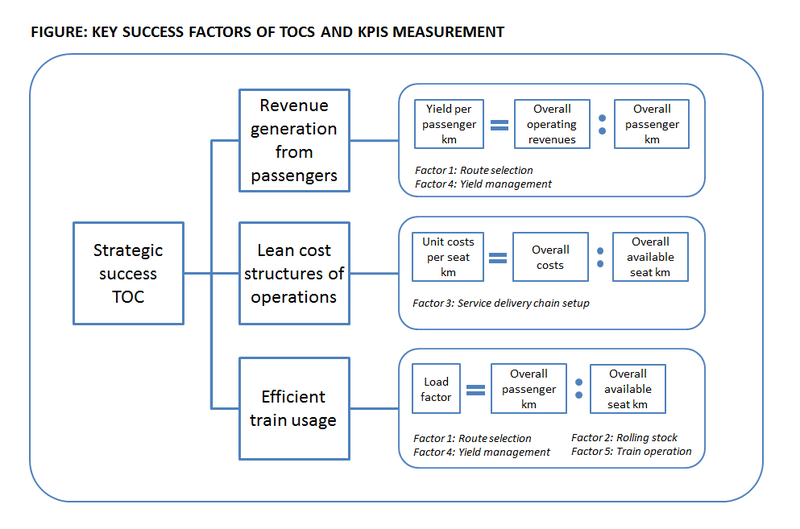Generic railway strategies TOCs
train operator strategies
a research-oriented knowledge base for train operating companies (TOCs)
a research-oriented knowledge base for train operating companies (TOCs)
4. Generic TOC strategies
The definition of generic viable strategic orientations is pursued in this chapter along Porter’s strategic concept of differentiation, focus and low-cost strategies (Porter, 1985, pp. 12-15). Within the strategic definition two major drivers can be identified. The chosen price segment of TOCs is seen as the crucial factor number one because the addressed pricing segment allows drawing conclusions on TOCs’ cost competitiveness. Prices are clustered into a low, a medium and a high segment.
The second chosen strategic factor relates to the core value of a transportation company, i.e. a TOCs’ geographic domain. The broader a TOC’s network the more revenues it generates and the stronger is its competitive position. The geographical presence of European long-distance passenger rail companies is clustered into single line operators, national operators, international operators (only selected connections to related countries to increase the domestic network’s reach) and European operators (present in several European countries with own facilities and a broad network coverage).
When combining theoretical and practical research findings of this thesis, three major generic strategic groups can be identified: Low price connectors, modern value carriers and network-focused operators. Each of them will be described in detail in the upcoming sections.
Additional figures:
When relating the gained understanding of the long-distance passenger rail business to its process chains, five key success factors (KSF) can be defined. Three of them are related to the initial business development chain, the other two lie in the service delivery process. The value chains and KSFs are presented in the figures below.
The definition of generic viable strategic orientations is pursued in this chapter along Porter’s strategic concept of differentiation, focus and low-cost strategies (Porter, 1985, pp. 12-15). Within the strategic definition two major drivers can be identified. The chosen price segment of TOCs is seen as the crucial factor number one because the addressed pricing segment allows drawing conclusions on TOCs’ cost competitiveness. Prices are clustered into a low, a medium and a high segment.
The second chosen strategic factor relates to the core value of a transportation company, i.e. a TOCs’ geographic domain. The broader a TOC’s network the more revenues it generates and the stronger is its competitive position. The geographical presence of European long-distance passenger rail companies is clustered into single line operators, national operators, international operators (only selected connections to related countries to increase the domestic network’s reach) and European operators (present in several European countries with own facilities and a broad network coverage).
When combining theoretical and practical research findings of this thesis, three major generic strategic groups can be identified: Low price connectors, modern value carriers and network-focused operators. Each of them will be described in detail in the upcoming sections.
Additional figures:



